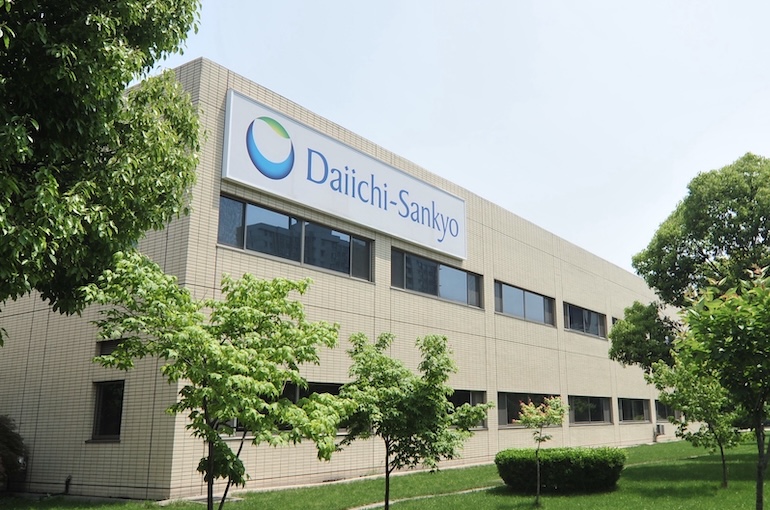 China to Keep Driving Pharma Industry Transformation, Daiichi Sankyo's China Head Says
China to Keep Driving Pharma Industry Transformation, Daiichi Sankyo's China Head Says(Yicai) Aug.29 -- China has been the innovation powerhouse of the pharmaceutical industry and will continue to hold this role in the years to come, according to the China president of Japanese pharmaceutical firm Daiichi Sankyo.
"I firmly believe China holds both tremendous growth potential and global strategic importance," Michio Hayashi, who was appointed Daiichi Sankyo China president in April, told Yicai in an exclusive interview. “As a powerhouse of global pharmaceutical innovation, China will continue to drive industry-wide transformation.”
China is the world's second-largest pharmaceutical market. It has a large scale, is experiencing rapid growth, and boasts strong policy support, according to Hayashi.

In oncology, China accounted for over 24.1 percent of new cancer cases and 26 percent of global cancer deaths last year, both the highest in the world, Hayashi noted, citing data from the National Cancer Center.
"In chronic diseases, nearly 400 million people in China live with chronic conditions," he added. “Cardiovascular and cerebrovascular diseases are the leading cause of death, so we have urgent needs for more treatment options.”
About the rapid growth, Hayashi pointed out that China is undergoing an accelerated demographic shift, with more than 20 percent of its population being above 60 years old at the end of last year.
"At the same time, with the continuous progression of Healthy China, the concept of 'health-centered' is deeply rooted in people's hearts," he added. "The huge demand, coupled with the rise in national health awareness, has led to the accelerated expansion of the healthcare market.
"The Chinese government has shown strong commitment to advancing innovative pharmaceuticals in recent years," Hayashi said, regarding the country's strong policy support. “Continued high-level opening-up and various pro-innovation policies have created a highly favorable environment for multinational pharma companies like us.”
Supportive policies include faster drug approvals, expanded National Drug Reimbursement List access, and flexible manufacturing frameworks.
On Aug. 22, the National Medical Products Administration approved Daiichi Sankyo's Datroway (datopotamab deruxtecan) for patients with previously treated metastatic HR Positive, HER2 Negative Breast Cancer, becoming the second DXd ADC approved in China after the company’s Enhertu (trastuzumab deruxtecan) in February 2023.
Manufacturing Investment
Last November, Daiichi Sankyo announced it would invest approximately CNY1.1 billion (USD150 million) to build a new ADC manufacturing facility in the Zhangjiang Hi-Tech Park in Shanghai's Pudong New Area to enhance its supply efficiency and acquire faster market response capabilities.
"The new facility in Zhangjiang will strengthen our local manufacturing capability to ensure stable supply and meet the growing demand for oncology therapies in China," Hayashi said, adding that, as one of Shanghai's first ADC segmented production pilot programs, it aligns with China's biomedicine policies.
The NMPA launched a pilot program on segmented production of biological products in October last year, enabling the segmented production of biologic products like ADC until the end of next year.
"By enabling specialization in different states of production, it [the pilot plan] lowers companies' fixed asset investment burden, unlocks innovation potential, and promotes a more specialized, high-end, and globally integrated supply chain," Hayashi explained.
ADC Portfolio Expansion Despite Competition
Daiichi Sankyo's DXd ADC platform is central to the company's leadership position in the precision oncology industry. The global ADC market logged nearly USD10.8 billion in sales last year, with Enhertu leading at USD3.8 billion (JPY552.8 billion), according to Market.us Media.
Chinese new ADC drugs account for 40 percent of the global pipeline, according to a report by Shanghai Pudong Development Bank International. From 2021 to 2024, the total business development transaction value in China's ADC sector exceeded USD40 billion.
According to Frost & Sullivan forecasts, China's ADC market is expected to grow from CNY800 million (USD111.8 million) in 2022 to CNY66.2 billion (USD9.3 billion) in 2030, achieving a compound annual growth rate of nearly 73 percent.
"Innovation always thrives in competition," Hayashi said. “China's rapid progress in ADC development is impressive. While it brings fierce competition, it also creates tremendous opportunities.”
Leading players in the Chinese ADC market include Biocytogen Pharmaceuticals, Hangzhou Dac Biotechnology, Shanghai Affinity Biopharmaceutical, and Suzhou Medilink Therapeutics.
Biocytogen Pharma leads peers by active pipeline ADC count, with 23 active ADC drugs in development. Hangzhou Dac, Affinity Biopharma, and Medilink Therapeutics are also very competitive.
"We welcome collaborative competition, as it is the patients who will truly benefit," Hayashi noted, adding that Daiichi Sankyo is expanding its research and development presence in China, with 30 clinical studies underway for DXd-based ADC drugs mainly targeting breast, lung, and gastric cancers.
"We are committed to making China one of our global R&D hubs," he pointed out.
Beyond ADC drugs, Daiichi Sankyo's pipeline includes therapies like Quizartinib, which is under review in China for the treatment of acute myeloid leukemia, and Valemetostat Tosilate, which was approved in Japan for adult T-cell leukemia/ lymphoma and for the treatment of relapsed or refractory peripheral T-cell lymphoma.
Challenges like high R&D costs and regulatory complexity persist, but Hayashi's strategy for Daiichi Sankyo China includes innovative payment models and partnerships to enhance affordability and clinical pathways. "These initiatives ensure timely access to innovative treatments for more Chinese patients," he explained.
Strategic Outlook
Daiichi Sankyo's Vision 2030 aims to become an innovative global healthcare company contributing to the sustainable development of society, with China as a cornerstone. The construction of the ADC facility in Shanghai, combined with the expanding R&D pipeline and reimbursement strategies, will help Daiichi Sankyo meet China's evolving needs.
For Daiichi Sankyo, this means deeper localization through more clinical trials tailored to Chinese patients, stronger partnerships with diverse stakeholders, and a pipeline addressing unmet needs, according to Hayashi.
"We will continue to serve as a bridge that connects global innovation with local needs, contributing not only to our own sustainable growth, but also to the well-being of Chinese patients," he said.
Editor: Futura Costaglione